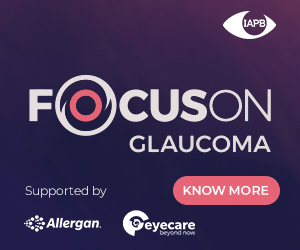Join a powerful, unprecedented alliance for better eye health for all.
Join IAPB-
Choose an alternate language here
For World Glaucoma Week, Dr. Sidi Mohamed Ezzouhairi pens a personal piece touching on IOP in glaucoma, the conflict of interest for ophthalmologists and more…
Glaucoma in Morocco, as in the rest of the world, represents the second leading cause of blindness. The burden of glaucoma, the silent thief of sight, is very high in Morocco and even more in the rest of Africa. The number of people with glaucoma is estimated to be around 600,000 patients. Of these, only 15% are treated compared to 50% in developed countries.
Several factors, that often coexist in the same patient, explain the severity of the disease in Morocco — melanoderma, the high prevalence of capsular exfoliation, angle closure and thin cornea… The frequency of exfoliation in our country is considered to be at 7.5%, with a peak over 80 years at 17.4%. (1)
Unfortunately, most patients are referred too late to our glaucoma facility, with very advanced and already symptomatic glaucoma.
The IOP represents the key element in the diagnosis and follow up of glaucoma patients. The following factors are important when interpreting IOP readings.
It is well known that the reduction of IOP lowers the risk of conversion into glaucoma, and lowers the progression of the disease as well. IOP is central in glaucoma diagnosis and management, and is certainly the only modifiable factor but other factors are worth considering when making the diagnosis and following up with patients.

Diagnostic tools, highlighting the central role of Optic Neuropathy (ON) structure and ON function, develop rapidly. Please let’s use them!
I think that the large randomized trials (OHTS, (2) AGIS (3,4,5) …) cannot be generalized to our population because they don’t consider elements, such as socio-economic background, geographical diversity, climatic diversity, and diet. All these factors could play a role in the individual response to glaucoma treatments. Nowadays, epigenetic underlines the influence of these factors on individual response to a given treatment (6).
Certain studies, influenced by industry lobbies, are built to discredit the traditional surgery. Trabeculectomy, should be our first surgery for glaucoma in Africa. It is the only viable alternative in our poor continent. The big comeback in glaucoma surgery is only directed towards the MIGS, a lucrative surgery for an already very rich pharma industry.
As ophthalmologists in developing countries, we find ourselves powerless against all these conflicts of interest.
The international expert, star among ophthalmologists, is proud of all his links with industry, and show them as trophies during his talks. General ophthalmologists don’t even notice the obvious conflicts of interest.
The final victims are always our patients abandoned by the system. To help these people, financial, human and logistical resources must be found. In Africa, the needs are so important, that we need to think of new efficient independent strategies.
I think that concrete actions are necessary even if they are not cost effective for the industry. They should be cost effective for humanity.
1-Ezzouhairi SM. Prevalence of exfoliation in Morocco, talk presented at Société Française d’Ophtalmologie (SFO) congress may 2015
2-Kass MA, Heuer DK, Higginbotham EJ, et al. The Ocular Hypertension Treatment Study: a randomized trial determines that topical ocular hypotensive medication delays or prevents the onset of primary open-angle glaucoma. Arch Ophthalmol. 2002;120:701-713.
3-The AGIS Investigators. The Advanced Glaucoma Intervention Study (AGIS): 1. Study design and methods and baseline characteristics of study patients. Control Clin Trials. 1994;15:299-325.
4-The AGIS Investigators. The Advanced Glaucoma Intervention Study (AGIS): 9. Comparison of glaucoma outcomes in black and white patients within treatment groups. Am J Ophthalmol. 2001;132:311-320.
5-The AGIS Investigators. The Advanced Glaucoma Intervention Study (AGIS): 3. Baseline characteristics of black and white patients. Ophthalmology. 1998;105:1137-1145.
6- Alkozi, H. A., Franco, R., & Pintor, J. J. (2017). Epigenetics in the Eye: An Overview of the Most Relevant Ocular Diseases. Frontiers in Genetics, 8.